A good interview/career analysis piece on Brokeback Mountain star Heath Ledger by Time‘s Belinda Luscombe (“Heath Turns It Around”). It reminded me of what I wrote hours after seeing Brokeback in Toronto, which was that between that and Ledger’s then-upcoming Casanova, he has saved his career. The 26 year-old Australian tells Luscombe that he pretty much decided to kill his movie-star persona after A Knight’s Tale, a film which made Ledger feel he was being sold and packaged as a slicked-up commodity. The result of Ledger’s Sean Penn-ish career stratgey since then was that, with the exception of Monster’s Ball, all the films he’s made have been critically slammed or strick out at the box-office, or both (Four Feathers, The Order, The Brothers Grimm, Lords of Dogtown). “Even if [Brokeback Mountain] pulls in crowds only in New York City, South Beach and San Francisco,” Luscombe writes, “it has redeemed Ledger from being a pawn — or even a knight — in the Hollywood chess game.”
So Time‘s Richard Schickel respects Brokeback Mountain for its “its assault on western mythology [and] its discovery of a subversive sexual honesty in an unexpected locale,” but feels it loses steam as it goes along and “finally fails to fully engage our emotions.” Odd how reactions can vary so greatly. For me the ending — the last 20 minutes especially — is the part that ties it all together and finds the primal emotional chord.
The following films are set for the 2006 Sundance Film Festival, which will run from Thursday, 1.19.06 through Sunday, 1.29.06: (1) Steven Shainberg’s Fur, the Diane Arbus biopic with Nicole Kidman and Robert Downey, Jr., from Picturehouse; (2) Brian DePalma’s The Black Dahlia, a period crime thriller with Josh Hartnett, Scarlett Johanson, Hilary Swank, Aaron Eckhardt; (3) Joby Harold’s Awake, a Weinstein Company thriller with Hayden Christensen, Sigourney Weaver, Jessica Alban; (4) Fabiane Bielinsky’s The Aura, an Argentine film about a taxidermist involved in criminal intrigue; (5) Terry Zwigoff’s Art School Confidential, a sardonic comedy about a young guy (Max Minghella) who enrolls in art school for curious fame-related reasons, with John Malkovich, Anjelica Huston, Jim Broadbent; (6) 0430, a totally non-verbal Singapore-produced film from director-writer Royston Tan, about a friendship between an 11 year-old boy and a man in his 30s; (7) Todd Yellin’s Brother’s Shadow, a Brooklyn-set drama about a black-sheep type (Scott Cohen) trying to step into the shoes of his deceased older sibling; (8) Neil Armfield’s Candy, a Down Under relationship drama with Heath Ledger, Abbie Cornish and Geoffrey Rush; (9) Nanda Anan’s City of Sand and Stone, an adventure piece about an American woman (Kelli Garner) unravelling some sort of mystery in India, with Justin Theroux and Frank Langella; (10) Fast Track, a Weinstein Co. comedy from director Jesse Peretz, with Jason Bateman, Amanda Peet, Paul Rudd and Mia Farrow; (11) Michael Lehmann’s Flakes, a quirky-behavior comedy with Aaron Stanford and Zooey Deschanel; (12) Nicole Holofcener’s Friends With Money, a relationship drama with Jennifer Aniston, Frances McDormand, Scott Caan; (13) Dito Montiel’s A Guide to Recognizing Your Saints, a New York-based drama with Chazz Palmintieri, Rosario Dawon, Robert Downey, Jr., and produced by Downey and Trudie Styler (i.e., Mrs. Sting); (14) Julian Goldberger’s The Hawk is Dying, a Florida-set drama with Paul Giamatti and Michael Pitt; (15) Klimt, about the last years of Austrian artist Gustav Klimt, with John Malkovich, Stephen Dillane and Saphron Burrows; (16) Lee Yoon-Ki’s Love Talk, a Korean-American drama set in Los Angeles; (17) Kevin Smith’s The Passion of the Clerks, with Brian O’Halloran, Jason Mewes, Jeff Anderson and Smith; (18) John Cameron Mitchell’s Shortbus about several New Yorkers “exploring” each other during a power outage; (19) Bruce Leddy’s Shut Up and Sing, a meditative comedy about an a capella singing group having a reunion; (20) Robert Benigni’s The Tiger and the Snow, about a love-struck Italian poet immersed in the American invasion of Iraq; (21) Carlos Borado’s What God Knows, a Brazilian drama with Diego Luna and Alicia Braga; and (22) Hilary Brougher’s Stephanie Daley, a drama about infanticide with Tilda Swinton and Amber Tamblyn. These 22 films are, of course, just the tip of the iceberg.
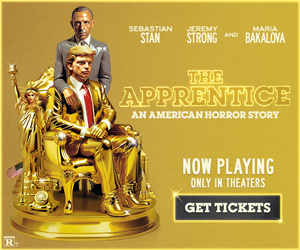
Step On It
Rob Marshall’s Memoirs of a Geisha (Columbia, 12.9) is this year’s model of the big bland Best Picture contender that everyone who isn’t a sucker for this kind of thing — expensive, beautifully produced, Oscar-hungry, terminally boring — needs to throw tomatoes at.
Seriously…let’s start the ball rolling now. IM your friends and coworkers and tell them you’ve heard it’s a tedious costume-movie drag, but also that it’s caught a certain headwind and there’s a slight chance it could metastasize into this year’s Chicago.
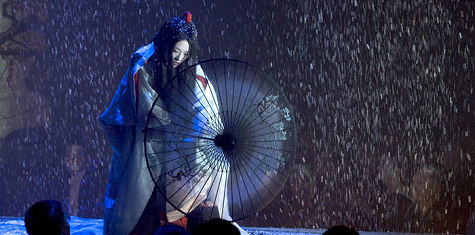
Ziyi Zhang during her big geisha-in-a-snowfall performance number that has zip to do with her character but a lot to do with Rob Marshall’s creative sensibility
The best thing about it is Gong Li’s performance as a jealous-bitch geisha in a Bette Davis mode. Otherwise the film is all costumes and pretty photography and a rags-to-riches story that creeps along at a petty pace.
It’s porcelain, nothing, stupefying…and every Godforsaken line of Chinese-accent English-language dialogue is like screeching chalk.
The first Academy-member Geisha screening happens tonight (11.21) so no pulse- readings until tomorrow, but there’s a poll of eleven connected journos that just went up today on Movie City News called “Gurus of Gold,” and Geisha is being project- ed as one the top five Best Picture contenders.
< ?php include ('/home/hollyw9/public_html/wired'); ?>
Two of the respondents — Variety guy and Maxim critic Pete Hammond and USA Today‘s Scott Bowles — are actually projecting it as the most likely Best Picture winner…at this juncture.
The stars of Memoirs of A Geisha are Ziyi Zhang, Michelle Yeoh and Gong Li… three famed Chinese actresses played Japanese geishas and speaking English …and the feeling of Hollywood fakery and retrograde attitudes is fairly relentless.
The same Anglos-first mentality that led to the casting of Marlon Brando as Sakini in The Teahouse of the August Moon (’56) and Ricardo Montalban as Nakamura in Sayonara (’57) has prevailed once again.

And at no point does Memoirs of a Geisha feel like anything more than a colorful but perfunctory corporate tour of an exotic culture, tailor-made for Disney World Americans who won’t pay to see movies with subtitles.
I can tolerate the three Chinese actresses playing Japanese (although Ziyi doesn’t look Japanese for a second, and there’s a clear genetic difference in the faces of the two peoples), but the language and accent barriers are impossible.
Marshall should have shot a Japanese-language version concurrently, which Columbia could have concurrently released into select big-city theatres. Difficult but not impossible, and then people like me would have had an easier time of it.
There’s a scene early on in which a pair of young sisters are about to be forcibly separated. A very traumatic thing, but if this were to happen in real life the sisters would be in such shock they’d probably whimper a little bit and spend most of their last few seconds just staring at each other. Not in Rob Marshall’s world. When Geisha‘s sisters are torn apart the more spirited of the two goes, “Noooooo!!”
That’s a bullshit Hollywood reaction. People in bad Hollywood movies always go “noooo!!” when something bad happens. In a way, the whole movie is like this one scene. I didn’t believe a word of it.
And I wonder if the women for whom it’s been made will either. And I doubt if any real critical support will manifest. A publicist friend tells me all the journos he’s spoken are saying “pretty to look at, but cold.”
Robin Swicord and Doug Wright’s script is based on Arthur Golden’s 1997 novel, which is a huge international best-seller. I think it’s safe to say that the movie will dampen interest in anyone who hasn’t yet read it wanting to do so. My God, who would want to take this journey twice?

Ziyi Zhang, Ken Watanebe
Set in Japan in the 1930s and ’40s, Geisha is essentially a Cinderella story, and there’s not a hint of story tension or rooting interest in any part of it.
A little Japanese girl (Suzuka Ohgo) who will eventually be called Sayuri is sold to a geisha house (called an “okiya”), kicked around and treated like a slave. She’s quite pretty as an adolescent and is considered a special standout because of a pair of very weird-looking blue eyes (which throw you completely out of the film because they look like dopey contact lenses, pure and simple).
And then she grows up to be Ziyi Zhang, who doesn’t resemble Ohgo in the slightest.
This much-celebrated 26 year-old actress gives her first nothing performance here. She brought a fierce glaring passion and a taut physicality to her roles in Crouch- ing Tiger, Hidden Dragon and Hero and found a sense of emotional truth in Wong Kar Wai’s 2046, but here she’s a piece of wood.
Gong Li wields a much sharper blade as Sayuri’s wicked geisha nemesis Hatsu- momo. She’s stuck in the same mediocre Rob Marshall movie, but there’s fire in her veins and the heat burns through, and right away she has you thinking impure thoughts.
Sayuri, in any event, is trained to be a geisha and soon gets into an ongoing generational cat-fight with the older Hatsumomo. Her ally is Yeoh’s Mameha, a 40ish geisha playing a stock older-mentor character, dispensing sage advice with the usual kindly-patient smile.
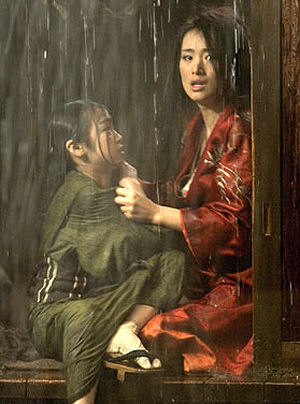
Suzuka Ohgo (l.), Gong Li
Eventually Sayuri meets Prince Charming in the form of a businessman called “The Chairman” (Ken Watanabe) and falls for him. The usual hurdles and compli- cations have to be overcome before Watanebe finally recognizes what a treasure she is and tells her he loves her.
I think I was a little happier than Sayuri was when this happened.
The most irritating performance is given by Kaori Memoi, who plays the crusty and conniving Mother, the head of Sayuri’s geisha house. Her English is so bad and so grating I literally twitched in my seat at one point.
The movie stays with the explanation in Golden’s novel about what being a geisha is all about, which is that geishas are in no way prostitutes and are more about being a very refined form of arm candy…a poised and disciplined ideal of Japanese femininity.
And yet somehow, despite all the talk about no sexual favors, Sayuri and Mameha end up doing some nocturnal skinny-dipping with a bunch of Japanese business- men and an American colonel (Ted Levine) in the third act.
A Japanese businessman admirer of Sayuri has asked her to cuddle up to the American Colonel so he get get a business deal out of him, and when Levine’s character makes a move a few minutes later Sayuri is shocked and offended.
This is ridiculous, and another reason I didn’t believe what the film was selling. Geishas are not hookers, okay, but all my life I’ve been told that carnal knowledge is sometimes part of the equation. You just have to be the right guy with the right attitude, the good manners of a gentleman and a lot of money.
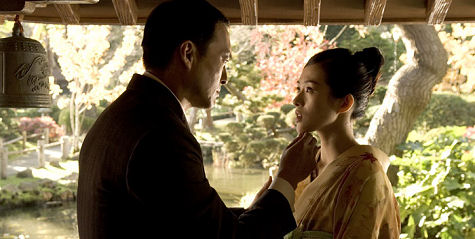
No one will argue with Geisha getting the usual below-the-line nominations that are always handed to a film of this type. Dion Beebe’s cinematography, John Myhre’s production design, Colleen Atwood’s costumes and John Williams’ score are all topnotch. What the hell, throw in nominations for the editor and the sound editing guys.
Geisha was mostly shot in the Los Angeles area (an outdoor Japanese village was built north of the city), including the Sony soundstages in Culver City. That means a lot of local people were paid top dollar, which tends to produce in the minds of Academy people an urge to reciprocate in the form of handing out Oscar nomina- tions in the less-important categories.
But classy window-dressings aren’t enough to justify nominating a film for Best Pic- ture. The above-the-line nutrition in Memoirs of a Geisha simply isn’t there, and no amount of cheerleading by its supporters is going to change that fact.
USC Interlude

Ain’t It Cool’s Drew McWeeny and yours truly paid a visit Monday night to Charles Fleming’s “Entertainment, Business and Media in Today’s Society” class at the USC School of Journalism. We talked about internet journalism, industry politics, survival skills, the shortcomings of Tom Rothman and what the students thought about the hot new movies. Defamer’s Mark Lisanti, profiled in the current issue of Los Angeles magazine, was supposed to show but bowed out at the last minute….something about his girlfriend having told him they already had “plans” (does that sound like a crock of shit or what?). Thanks to Fleming (pictured at left with the suit and tie) for having us down.
L.A. Times reporter Claudia Eller has a first-rate piece about the years and years it took to bring Rent (Columbia, 11.23) to the screen, but why has almost every article I’ve read about this Chris Columbus film contain an allusion to a possibly cloudy box-office future? It’s not the deepest or most complex thing you’ll ever see — Rent is Rent — but Columbus has done it proud. “In its vibrant, open-hearted, selling-the-hell-out-of-each-and-every- song-and-dance-number way, Rent is a knockout,” I wrote earlier this month, “and an ass-whooper and damn near glorious at times. I didn’t just like it…I felt dazzled, amped, alpha-vibed… people were applauding after almost every song, and the film really does give you a ‘whoa… this is special’ feeling.” Today’s tracking figures show 77% general awareness, 31% definite awareness and 7% first choice. A friend who supplied these numbers says the people at Revolution and Columbia “know there’s no heat on it…it’s just not ‘there’ and it’s not going to improve with age.” This is what’s known as a classic Hollywood disconnect. The movie gets what a very popular stage musical was all about and it plays like gangbusters (to me and the crowd I saw it with anyway), and so naturally…of course!…audiences aren’t going to support it all that much.
Let the word go forth from this time and place that the the new King Kong DVD (Warner Home Video, 11.22) has a wonderfuly detailed multi-chapter “making of” documentary, but (and I’m very sorry to report this) the film itself doesn’t look that fantastic. Maybe a little bit better than versions shown on VHS and laser disc, but there’s no great visual-leap factor. The film is marked by the same dirt and grain and speckles its had since playing on “Million Dolar Movie” in the 1950s. WHV should have John Lowry-ed this thing — i.e., removed a portion of the grain (i.e., not a Lowry Sunset Boulevard treatment but the kind of treatment that was given to Casablanca ) and cleaned it up on a frame-by- frame basis. But some Warner Home Video fuddy-duddy said “nope…leave it as it is, dirt and grain intact…it’s more pure that way.” One very cool thing: Max Steiner’s Kong overture that precedes the start of the film.

If anyone wants to talk about anything during tomorrow’s debut airing of Elsewhere Live, send an e-mail with your phone number any time between tonight and when the show starts at 7 pm Sunday…and tell me what you want to discuss. If you really want to get my attention, send an AOL Instant Message — my AOL user name is gzornplatt2.
I was right about Walk the Line exceeding expectations. (One of the film’s p.r. reps was urging me to go with a safe projection of $15 million or so.) Jim Mangold’s Johhny Cash biopic did about $7.7 million yesterday, so figure about triple that for the weekend. And I hear the cards have been very good-to-excellent all along. The ace-in-the-hole is that it’s doing especially well among red-state rurals. In short, a very good showing over a weekend totally swampled by Harry Potter and the Goblet of Fire ($39 million yesterday — i.e., Friday — and a total of about $120 million by Sunday night).
A smart, strongly worded piece by the Hollywood Reporter‘s Anne Thompson about how the big-studio marketing departments only know how to sell fat tentpole movies these days, and why they should let their indie “dependent” divisions make and market the smaller-budgeted, character-driven quality level stuff. Probably true, but Thompson comes to her conclusion because of the failure of six character-driven films releases by the majors: 20th Century Fox’s In Her Shoes and Stay, North Country and Kiss Kiss, Bang Bang from Warner Bros. and Paramount’s Elizabethtown and The Weather Man. The truth is that only one out of the six — In Her Shoes — was half-screwed by bad marketing (i.e., a trailer that made it look too chick-flicky). The other five totally shot themselves in the foot. Stay because it wasn’t much good. The Weather Man by being one of the worst soul-suffocating downers in movie history. Elizabethtown because it wasn’t good enough. Kiss Kiss Bang Bang because it was too glib by half and basically about its own cleverness. And North Country because a court case about sexual harassment is fodder for a 1985 TV movie.

The Hollywood Foreign Press has voted to move Hustle & Flow into the Drama category. This means Hustle star Terrence Howard will have to be nominated for Best Actor, and not Best Actor in a Musical, and if he gets nominated (which of course he should be…he’s monumental in that role) he’ll be going up against Heath Ledger, Phillip Seymour Hoffman and Ralph Fiennes…and one of those three will almost certainly win. So even though it’s idiotic (to put it mildly) to call Hustle & Flow a musical, the HFPA should have stuck to their loony-tunes classification because now the most Howard can look forward to is a Best Actor nomination. Bottom line: the HFPA has basically fucked him.
Cowpoke Surge
It’s time to say it straight (and I don’t mean that as a pun): Ang Lee’s Brokeback Mountain (Focus Features, 12.9) is the movie to beat in the Best Picture race this year.
I’m not saying it will win or lose, but it’s the one film everyone in the country will be talking about over the next five or six weeks and deciding where they stand deep down. And it’s safe to say that a lot of convictions about this film will go far beyond issues of cinematic criteria.
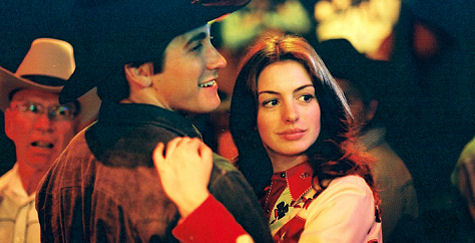
On the brink of a dishonest marriage: Jake Gyllenhaal, Anne Hathaway in Ang Lee’s Brokeback Mountain (Focus Features, 12.9)
The bottom line is that Brokeback Mountain is the only year-end prestige film that people are weeping over, and that matters. On top of which it has a simple philoso- phical theme (i.e., ignore the pleadings of your heart at your own peril), which all Best Picture winners tend to have.
This is mostly a gut feeling, but I’ve called around a bit and it’s the one film that seems to be truly gathering steam within L.A. and N.Y. screening circles (except for certain conservative harumphers and macho conquistadors) as an enlightened stand-out.
It’s the classiest tearjerker. The most bravely made. The year’s one big deck-re- shuffler. The stand-alone-under-a-lonely-nightscape movie that did something new and head-turning. A film that brought a sense of real compassion and vulnerability to the table, and is sure to goad anyone who sees it into a deeper understanding of what comprises human tragedy.
< ?php include ('/home/hollyw9/public_html/wired'); ?>
I haven’t conducted any kind of scientific poll, but I’m hearing that Academy mem- bers are saying to each other than Brokeback Mountain is an almost-certain Best Picture nominee, which confirms what I’ve long believed would eventually happen anyway.
But I have to acknowledge something else, however reluctantly, which is that there are people out there who are not on the team and never will be.
Brokeback Mountain is at heart an emotionally shielded and heterosexual-attitude piece about two rugged western guys named Jack Twist (Jake Gyllenhaal) and En- nis del Mar (Heath Ledger) who fall in love with each other in their early 20s and spend the rest of their lives feeling all screwed up about it.
They both get married and have kids and take a stab at conventional domesticity while continuing to get together for “fishing trips” now and then. But the denial fes- ters and eats away. Ledger’s gruff, emotionally plugged-up cowhand is especially unable to act on his feelings for Twist in any lasting way, and all kinds of bad stuff kicks in down the road.
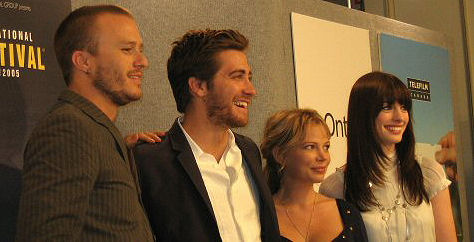
Brokeback Mountain‘s Heath Ledger, Jake Gyllenhaal, Michelle Williams and Anne Hathaway at Toronto Film Festival press conference for the film.
My repeated promises that this film isn’t gay are getting tiresome, but it really and truly isn’t. But those nagging impressions about it being a “gay cowboy” movie aren’t going to go away, and the more recent (and catchy) “gay Gone With the Wind” label is going to stick also.
And I’m afraid…I’ll just spit it out…that homophobia and closet bubba-ism (which is a bigger factor than some of us may realize) are going to start elbowing their way into the Brokeback Mountain conversation over the next several weeks.
I’ve been picking up indications of resistance in letters here and there…just hints and simmerings (following this article is a letter from a 26 year-old Milwaukee guy who’s been picking up a certain vibe when the trailer plays)…but I’m starting to sense there may be more where this comes from.
And I’d be kidding myself if I didn’t admit to the possibility of a subterranean, grumpy-straight-male, anything-but-Brokeback groundswell. If there’s enough heft behind this, there’s a chance that the scales could tip against Lee and producer James Schamus and everyone who loves and supports this film.
The fact that Matt Drudge, a conduit of conservative opinion but also a guy with a very sharp nose for what’s happening in the hinterlands, has run at least two uh-oh items about Brokeback Mountain… this is a significant barometric reading.
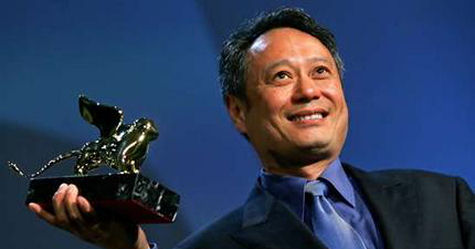
Brokeback Mountain director Ang Lee after winning the Golden Lion at last September’s Venice Film Festival
Focus Features wants to take the high road and I understand that, but The Battle of Brokeback Mountain is starting to take shape, and will fundamentlally be about whether people can look beyond their personal agendas and aversions and look into the fundamental truths contained in its story.
The more I consider the competition, the more I’m persuaded that no other film has come close to staking out, much less laying claim to, the emotional turf occupied by Brokeback Mountain.
The issue of whether or not it will gather more support than Steven Spielberg’s Munich, which my ass-teletype and insect-antennae readings keep telling me is going to be received in a couple of weeks’ time as a pretty good film but which has almost no chance of being this year’s Million Dollar Baby, is almost moot at this stage.
How can I say that? What do I know? But just wait.
The older ooh-ahh crowd…the journalists and Academy members who voted or campaigned for Rob Marshall’s Chicago two years ago…seem to be lining up behind Memoirs of a Geisha, and already I can see this emerging as a possible anything-but-Brokeback alternative (although I gag at the thought).
Capote is a sublimely haunted film that gets better every time you re-see it or think back on it. The New World will almost certainly be a compositional stunner (and perhaps more). Crash broke through and found its audience and deserves an industry-wide salute. And The Constant Gardener is thrillingly crafted piece that fuses the emotional and political into a kind of African third-world symphony.
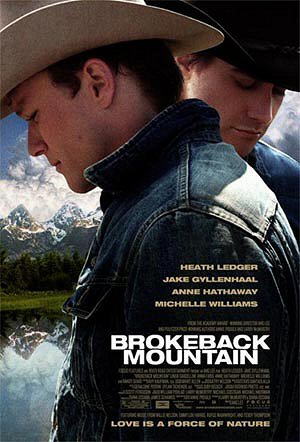
But Brokeback Mountain is the daddy…the one movie with a grip on a profound human truth that we all recognize.
This is what we’re all sitting on…the rumble of mid-November. And the question seems to be whether or not the resistant types out there will summon the char- acter to overcome their macho chortlings about the cornholing-in-the-tent-on-the- fishing-trips, and find the calm and coolness that will allow them to be big-hearted and open-hearted enough to…fuck it…let this film in.
We’re all lonely. We’ve all let chances at happiness slip through our fingers. Life is so damn short it’s not funny. What we feel in our hearts we’d better damn well act upon, or we’ll sure as shit feel the consequences down the road.
Attaboy
Thanks to Buffalo News columnist Greg Connors for giving me and this column a plug in last Monday’s edition.
Milwaukee, Baby
“I’m starting to worry about Brokeback Mountain‘s appeal in Milwaukee and surrounding environs. I live in Milwaukee and we have two Landmark theatres here — the Oriental and the Downer. And the trailer for BBM has been playing for a month or so in front of most films at both theaters, and I’ve seen it about four or five times within that time period.
“Though the audience is pretty typical for an art house/indie theatre, reactions have not been positive. Each time I’ve felt something like confusion, followed by the reali- zation that it’s ‘the gay cowboy movie.’ followed by either snickering or outright laughter. It seems like people don’t know what to make of it.
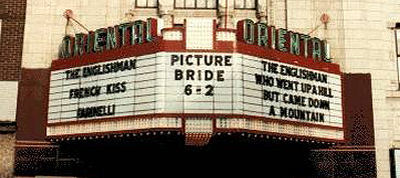
Landmark’s Oriental theatre in Milwaukee, haven to a group of Brokeback snickerers whose numbers are undetermined.
“I know the people I was at the theatre with snickered. Some had heard of it and some had not. But when they realize that it’s a love story between two cowboys, they laugh…regardless of whether or not they had heard of it.
“Not that I’d know how to sell it any better than Focus has. I hope I’m wrong. I think it looks great and I can’t wait to see it.
“I am 26. I would say that the snickerers in the audiences I’ve seen the trailer with are on the younger side. Maybe younger viewers just aren’t interested in Brokeback Mountain and that’ll be that.” — Paul Doro, Milwaukee, WI.

Another place for chortlers and snickerers to congregate
Young-male aversion to the trailer is mentioned in Sean Smith’s currently-running Newsweek story about Brokeback Mountain.
By way of Smith, producer James Schamus addresses the guys who are laughing at the trailers: ‘If you have a problem with the subject matter, that’s your problem, not mine,’ he says. ‘It would be great if you got over your problem, but I’m not sitting here trying to figure out how to help you with it.’
Smith also reports, “In an early meeting, Schamus told Lee that, from a marketing standpoint, they were making this film for one core audience. ‘Yes, of course,’ Lee said. ‘The gay audience.’ No, Schamus said. ‘Women.'”
Cash It
Editor’s note: I’m re-running the review I ran last September about Walk the Line because it opens tomorrow on Friday, 11.18.]
Walk the Line (20th Century Fox, 11.18) is a frank, straight-from the-shoulder bio- pic about the late Johnny Cash, and I’m cool with it and admire it in most of the ways that usually count.
For above all (and because there are many pleasures in the way it unfolds), Walk the Line is a solid, strongly composed thing — cleanly rendered and always touch- ing the bottom of the pool.
Just as George Clooney’s Good Night, and Good Luck plays, appropriately, like a live 1950s TV drama, Walk the Line is constructed and delivers like a good Johnny Cash song…no b.s., down to it, hurtin’ feelings, etc.

Walk the Line costars Joaquin Phoenix (as Johnny Cash) and Reese Witherspoon (as June Carter)
It’s easily Mangold’s best film ever, and from the guy who directed Girl Interrupted, the respectable Cop Land, the unsettling Identity, the nicely composed Kate & Leopold and the excellent Heavy, that’s saying something.
And you can definitely take Joaquin Phoenix and Reese Witherspoon’s performances as Cash and the apple of his eye, June Carter, to the bank. They’re both spot-on…fully believable, living and breathing on their own jazz, and doing their own singing and knocking down any resistance or concerns you might have about either one being able to inhabit or become the real deal.
Phoenix is a lock for a Best Actor nomination, and Witherspoon for a Best Actress nom — no question.
You will not in any way feel burned by this movie, and in many ways it will leave you with a feeling of finely-honed honesty and conviction…isn’t that the bottom line?
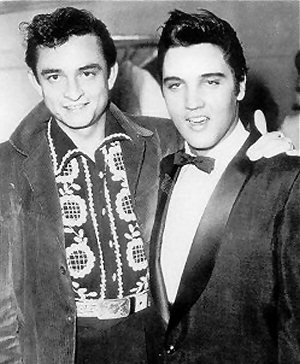
Johnny Cash and Elvis Presley, backstage after a show they gave in ’56.
At the same time I have to be dirt straight and say that the story of the film, which can basically be boiled down to “when will Johnny and June finally get married?”, didn’t exactly throttle me.
Walk the Line is very austere and manly, but when you look at it in sections, it’s just a standard showbiz saga progression thing…this happened, that happened, this happened, etc.
But the real reason it might run into trouble with the Academy is one that David Poland alluded to last summer, which is that Walk the Line is a bit too much like Ray…it’s too deja-vu.
Both films tell stories about a famous but flawed musical performer…the boy-born-into-southern-poverty thing, the rural hand-to-mouth upbringing, the sympathetic loving mother, the brother dying in childhood and marking the singer-to-be for life, an early marriage followed by drug abuse and infidelity, the cleanup detox scene, etc.
And frankly? It doesn’t get you emotionally all that much, although it does get you in retrospect because it feels honest and solid and doesn’t flit around. This movie never snickers or leers or tugs at your shirtsleeves — it says it plain, take it or leave it. And that grows on you.

The basic arc of this thing is, when will Johnny Cash attain a state of togetherness and a lack of encumbrance due to this or that gnarly issue (drug problems, marriage to first wife, etc.) to finally win over June Carter and get her to accept his marriage proposals? When will Johnny and June finally get hitched? That’s the basic shot.
It’s not meant as a put-down, but I don’t happen to feel that this or that woman (I don’t care how beautiful or giving or strong-of-spirit she is) can save any man’s life. Happiness can only be self-created — it must come from within.
I understand and respect that Johnny felt differently and needed June like a rose needs rainwater, etc., but I couldn’t empathize.
But I did feel it…that’s the odd thing. I felt a sense of absolute completeness, of bare-boned reality and complexity…in no persistent way did Walk the Line make me feel under-nourished.
Make of this what you will. I obviously can’t figure it out myself, but I’ve tried to be true to the spirit of this film by just saying it and letting the chips fall.
Wham Bam
Cinderella Man re-opens this Friday in a bid to get people to reconsider it for Oscar nomination, and maybe to make a bit more money. The most honest thing I can do is to re-print what I wrote late last May, the morning after seeing it at the AMC Empire on 42nd Street:
It isn’t quite stupendous, but Cinderella Man is honest and earnest and has dignity and heart, and if you don’t respond to it on some deep-down human level there’s probably something you should have inside that’s not there.
It’s easily the best, most emotionally rewarding mainstream flick of the year so far, and that’s not a left-handed way of saying it’s the best application of traditional thematic uplift…although it is that, I suppose.
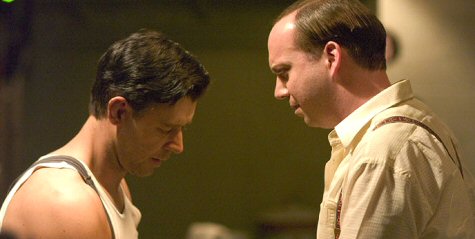
Russell Crowe as the legendary Jim Braddock, Paul Giamatti as his manager Joe Gould in Ron Howard’s Cinderella Man.
Like Seabiscuit, Cinderella Man is a 1930s Depression saga about a sports figure — an Irish boxer named James Braddock (Russell Crowe) — who was up and flush in the late 20s and then down after the 1929 crash and then fighting badly and presumed to be over…like a lot of people were assuming about themselves and even the country as a whole.
But then Braddock lucked into another chance and made good on it big-time by taking the heavyweight championship title from the formidable Max Baer, who had killed a guy in the ring and maybe another one besides (a delayed response thing), and in so doing struck a chord with working people struggling to make do in that horrible period.
The mythological similarities aside, Cinderella Man has been crafted by director Ron Howard with a good deal more poignancy and grace and laid-back confidence than Gary Ross was able to summon for Seabiscuit.
And Crowe can act circles around the horses who played Seabiscuit, and looks an awful lot like the real Jim Braddock…as far as his weight loss and genetic inheritance and the first-rate makeup allow for, I mean.
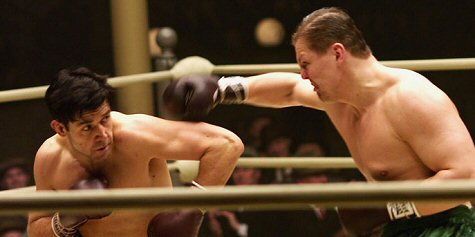
Cinderella Man also has the absolutely genius-level Paul Giamatti, who got a round of applause during the closing credits at last night’s all-media screening at Manhattan’s AMC Empire 25.
Let’s say it right here and now — Giamatti is a guaranteed lock for a Best Supporting Actor nomination next year.
It’s way too early to even think about making blanket calls about winners, but given the fact that everyone knows that Giamatti has been burned twice — last year when he wasn’t nominated for Best Actor for Sideways and the year before when the Academy ignored his American Splendor performance — he’s looking like a very heavily favored guy at this stage.
Every movie that connects with audiences says something that everyone including your grandfather recognizes as honest and true. The message of Cinderella Man, simply put, is that there’s nothing like getting heavily and repeatedly kicked in the ass (like having to deal with hopelessness and soup kitchens and bread lines, having no job, being unable to pay the electricity bill, seeing your kids go hungry) to give your life a certain focus.
What did I love about Cinderella Man the most, apart from the story and production designer Wynn Thomas’s convincing `30s milieu and Salvatore Totino’s cinematography and the pitchperfect performances? The fact that Howard hangs back for the most part and doesn’t push the emotional buttons too strongly.
I love that after an establishing prologue of six or seven minutes Howard takes things into a downer struggling mode and keeps them there for a full 45 minutes.
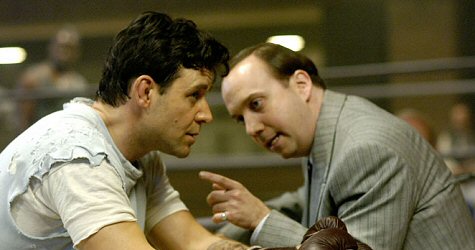
And then when the turnaround stuff finally starts to happen he doesn’t lather it and try and beat you up with it. We know that the story is a classic come-from-behind uplifter and this is why Howard is making the film, etc., but it doesn’t feel as if he’s hustling you. He’s telling a true story, after all, and holding back for the most part and just letting it come together on its own terms.
Okay, he throws in some inspirational Irish music here and there and gives us a few Ron Howard-y touches here and there, but not so you’d really notice.
Over the last few years, and particularly since he got into his 50s, Ron Howard has been getting better and better. A Beautiful Mind, The Missing (an undervalued, tough-as-nails western) and now this…perhaps the best film of his life.
Cinderella Man is longish (two hours and 20 minutes), but it doesn’t feel that way because the attention paid to this and that detail in the early sections totally pays off in the third act. Congratulations to Howard, his partner/producer Brian Grazer, and screenwriters Cliff Hollingsworth and Akiva Goldsman (A Beautiful Mind ) for deciding to let the story takes its time and in so doing imparts a certain confidence.
The climax of the down period comes when the destitute Braddock, desperate to get the power in his family’s cold-water flat turned back on, goes to a bar to beg change from his former cronies and supporters in the boxing game. It’s a painful scene, but it’s real and believable and penetrating as hell.
The five or six fight sequences are exciting and beautifully cut, and I didn’t care if they were as original as Scorsese’s Raging Bull sequences appeared back in `80.

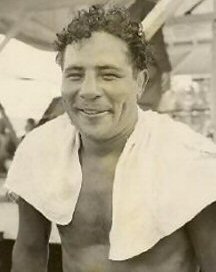
The real Jim Braddock (left) and Max Baer, in snaps taken sometime around 1934 or ’35 or thereabouts.
The big climax, which lasts about 25 or 26 minutes, depicts, of course, Braddock’s fight against the heavyweight champion Max Baer (Craig Bierko). I knew who the winner would be, obviously, but it didn’t matter because the film is so well shot and edited, blah, blah.
Crowe’s performance is an absolute home run. As Braddock’s wife Mae, Renee Zellweger gives her least tedious and off-putting performance since Jerry Maguire. (She almost made me forget about the last Bridget Jones film.)
Bierko’s Baer is a trip and a half. I loved his wild-ass expressions and goofing off in the ring, and how he flips this over in an instant and turns into a beast out for blood.
I loved Bruce McGill’s hard-nosed fight promoter character. McGill nails it every time (Collateral, Matchstick Men, The Insider) and has become one of most dependable character actors around, bar none.
I even found a place in my heart for Paddy Considine’s friend-of-Jim-Braddock character…a political activist-slash-working man….and that’s saying something given my lingering feelings about that “fee-fi-fo-fum” scene in Jim Sheridan’s In America.
War of the Wires
“The question about whether Paramount Home Video should have erased the wires in the just-out DVD of George Pal and Byron Haskin’s War of the Worlds should be simple, but it has somehow become more complex.
“The basis of any serious film restoration is now, and has always been, reference to the original. Not the original negative — the original print.
“With any production, not even specifically special-effects films, the film’s creators had a knowledge of what the shot footage would yield on a final print. Costumes, sets, make-up and special effects devices were all based upon that specific knowledge.

“The problems began in the late 1980s, when Kodak’s newest mastering
and print release stocks for both B & W as well as color emulsions were produced with a much finer grain structure. And make no mistake — that was a good thing.
“It began to combine in the ’90s with newer film-to-tape transfer technologies which enabled a higher resolved record of the film image.
“We saw the earliest problems on what were beautifully rendered laser discs of the Chaplin classics from Image Entertainment. The best people were brought in to go through the elements and oversee the work.
“But here’s where it gets difficult. One might make the assumption that access to an original fine grain master of, let’s say, City Lights or The Circus would be a great thing. And it was.
“But Chaplin had taken that master, and from it created a dupe printing negative from which final release prints would have been struck.
“Chaplin, a master filmmaker, knew precisely what affect optics and grain structure would have on his final product.
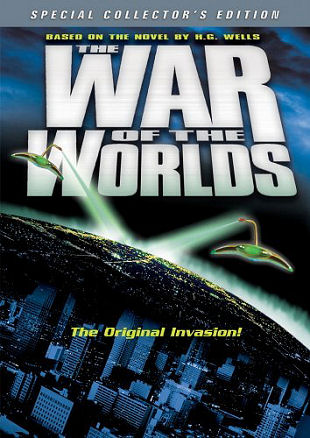
“Take away one generation and suddenly we see production artifacts like wires.
“This same thing occurred with 70mm prints of 2001: A opace Odyssey struck on the newer stocks. Because of the higher resolution, the glass holding the revolving pen on the spaceship heading to Clavius could now be easily seen in theatrical projection.
“Although I haven’t seen an original dye transfer print of WotW in decades, I can tell you that the system worked as follows.
“In 1953 Technicolor was using optics which are nowhere near the resolution of today’s scanning devices. This softened the image, yielding a more pleasant, less grainy look to the film.
“The mordant which allowed the liquid dyes to adhere to the blank stock was also slightly different than used later, and allowed a very slight softening of the grain structure.
“The final look of the print was achieved by the optics used in the creation of the printing matrices, the mordant, and the liquid dyes. The image looked perfect and brilliant on screen because of the slightly higher contrast of the Technicolor system which created a higher perceived sharpness — not actual sharpness.

“Taking those three-strip elements today and negating everything that came between them and the final print can yield a final result which is of overall higher resolution than the original prints. Hence the quandary, and there are two camps.
“My belief is that anything that breaks the suspension-of-disbelief
between the film and the audience should be altered to look as it
did, but now within an overall image of higher resolution.
“So personally I would remove the wires, as I would remove bad matte lines which can make early effects laughable and stop a film in its tracks, making it look like an antique.” — Robert Harris, the producer-scholar who supervised the legendary photo-chemical restorations of Lawrence of Arabia, Vertigo, Spartacus, Rear Window, etc.
Fatigue Guy
“During my prior life as a Merrill Lynch stock analyst, I was quoted as saying this about Harry Potter fatigue. In the fifth paragraph from the bottom, I mean.
“And I was kind of right — each successive film has done less box office than the previous, but of course the books are still boffo.” — Dave Lichtman
One thing is clear about the box-office come early December: Disney’s The Chronicles of Narnia: The Lion, The Witch and The Wardrobe (openign 12.9) will be through the roof.

 Really Nice Ride
Really Nice RideTo my great surprise and delight, Christy Hall‘s Daddio, which I was remiss in not seeing during last year’s Telluride...
More »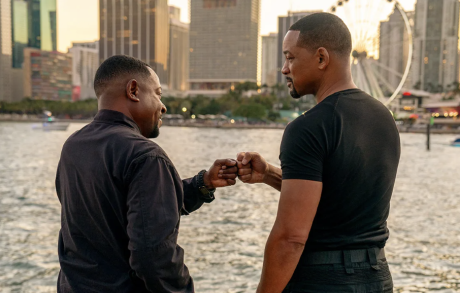 Live-Blogging “Bad Boys: Ride or Die”
Live-Blogging “Bad Boys: Ride or Die”7:45 pm: Okay, the initial light-hearted section (repartee, wedding, hospital, afterlife Joey Pants, healthy diet) was enjoyable, but Jesus, when...
More »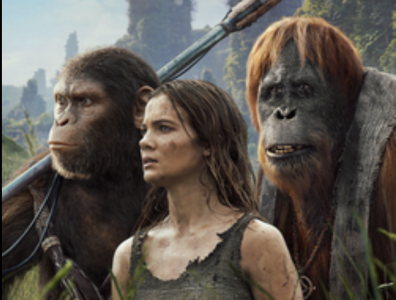 One of the Better Apes Franchise Flicks
One of the Better Apes Franchise FlicksIt took me a full month to see Wes Ball and Josh Friedman‘s Kingdom of the Planet of the Apes...
More »
- The Pull of Exceptional History
The Kamala surge is, I believe, mainly about two things — (a) people feeling lit up or joyful about being...
More » 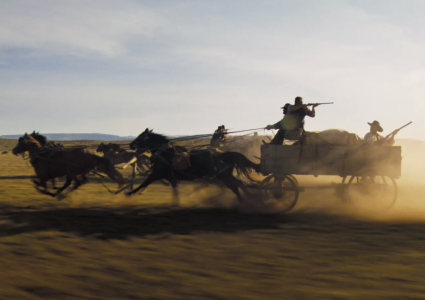 If I Was Costner, I’d Probably Throw In The Towel
If I Was Costner, I’d Probably Throw In The TowelUnless Part Two of Kevin Costner‘s Horizon (Warner Bros., 8.16) somehow improves upon the sluggish initial installment and delivers something...
More » Delicious, Demonic Otto Gross
Delicious, Demonic Otto GrossFor me, A Dangerous Method (2011) is David Cronenberg‘s tastiest and wickedest film — intense, sexually upfront and occasionally arousing...
More »


